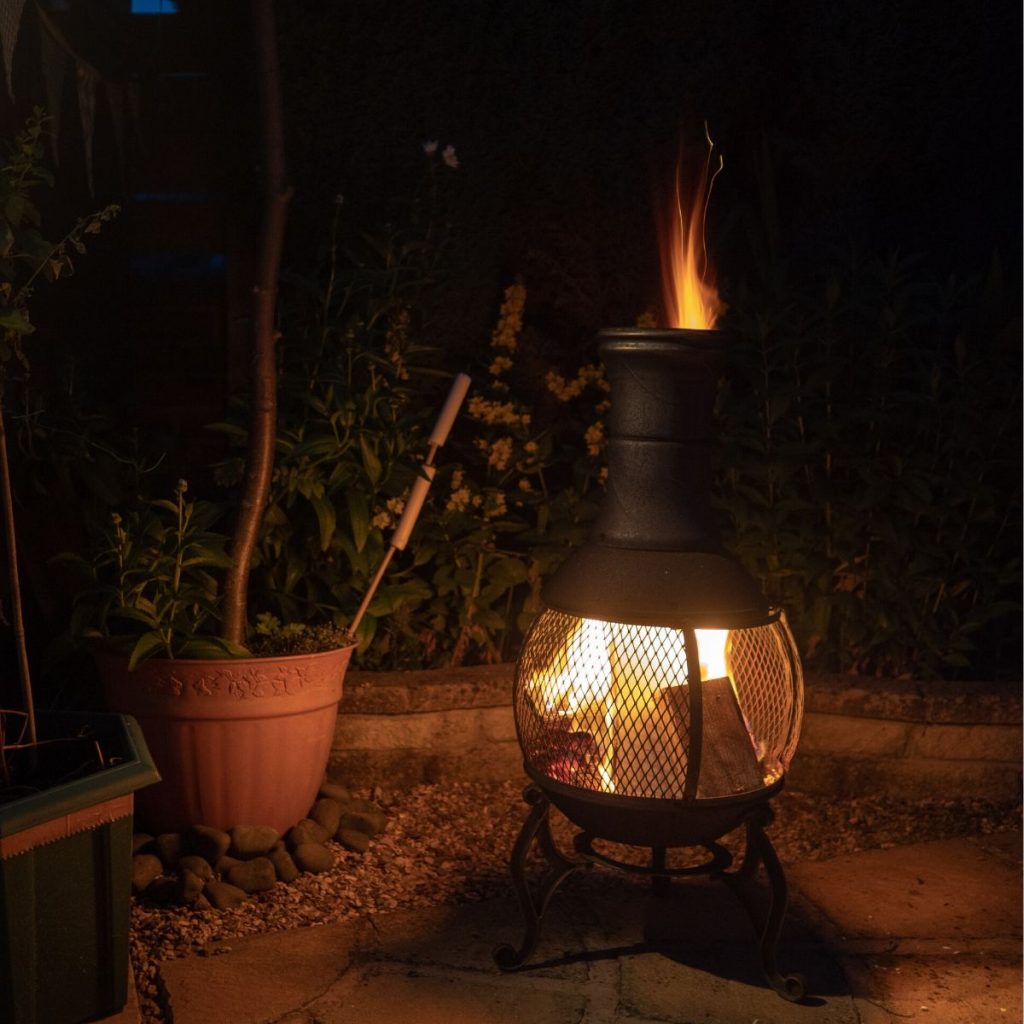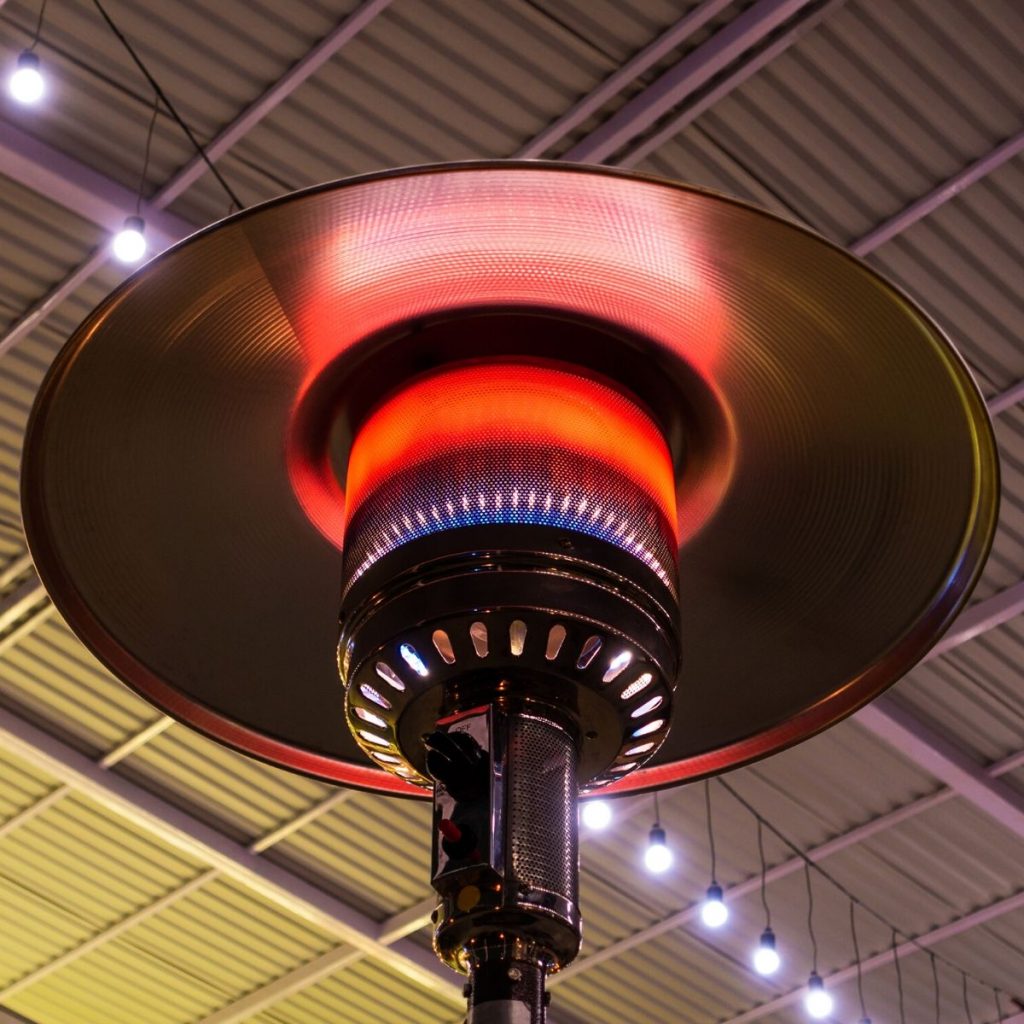A good outdoor heater can rescue you on those blissful nights! There are so many outdoor and garden heaters to choose from, but which is right for your needs?
From maximum heating area, cleaning and maintenance needs, to types of fuel available, each has its own unique advantages and disadvantages and sometimes its tricky to get the right fit first try.
Here at PatioMate HQ, we are committed to helping you make the best decision first time around, saving you money and potential disappointment in the long run.
Fire pits, patio heaters, and chimineas. All three are tempting and luxurious additions to any garden or outdoor space. You can even replicate the ambience of you favourite pub garden or dine alfresco late into the evening without need to purchase a BBQ.
We’ll help guide you to the perfect solution to fit your needs in our free handy guide below.
In This Guide

Fire Pits
Fire pits will give you the authentic touch, they are undeniably cosy and provide fantastic ambience, adding incredible atmosphere to any suitable location.
As with all heaters, but with fire pits in particular, great care should be taken around open flames. Whether you’re using charcoal, fire-wood or gas, it’s important to keep an eye on the fire and ensure children, pets and flammable items are kept at a safe distance.
Fire pits are notorious for embers flitting out and due to the open nature of them, it can be quite difficult to ensure safety if you’ve got wandering pets or young children in the area.
However, there are an array of fire pits with grates and guards that can minimise the risk, but it is a risk all the same and worth noting.
Fire pits come in all styles, shapes and sizes. You can find them constructed from copper, steel aluminium, stone, ceramic or most popularly cast iron.
Permanent fixtures and portable pits are on offer. Fantastic if you’re planning on moving house and want to bring your fire pit with you.
Equally if you’re intending on building a fire pit as a permanent fixture to spruce up the outside space of your AirBnB, hotel, restaurant or pub and want to minimise the risk of damage from clientele then this might be the best option for you.
Pros
Fire pits are essentially outdoor fireplaces, they add a warm rustic feel to the space and provide much needed light and heat on cold nights.
Just don’t be tempted to hang your stockings above it! Whether you choose a built-in permanent fire pit or a smaller portable fire pit, you’re maximising your time spent outdoors in the coziest possible way.
Fire pits don’t just heat the garden or patio area, they become quite a magnificent centrepiece to admire fondly too. Permanent fire pits have been known to increase the value of a property and most definitely become a talking point for friends and family who visit.
Most fire pits are not too big in size, which is ideal for social gatherings. Many people can sit around it like a campfire and equally enjoy the warmth and dreamy setting into the early hours. Parties, BBQs, sleepovers, and even back garden wedding receptions are all immediately complimented by a well tended to fire pit in attendance.
Not forgetting of course, that some fire pits can serve as a barbecue or smoker in their own right saving the need to purchase a barbecue for smaller gatherings or doubling cooking capacity for the larger ones.
Fire pits come in all shapes and sizes, you can spend as much or as little as you want on them depending on your available budget making them a great beginners choice.

Cons
With a fire pit, you’re getting all the benefits of raw fire, but depending on the type of fuel you choose, you may have smoke and leftover ash to contend with.
Stray embers can be a cause for concern with young children or pets around.
Cleaning up the soot, the black sludge that seeps through after a rainy day, and assuring safe measures are being taken to keep any potentially wandering embers where they belong are all important parts of being a fire pit owner.
Of course this care takes time, where other outdoor heating methods may require less upkeep.
TIP: To avoid the soot and sludge ruining your patio or garden, we recommend positioning your fire pit over a bed of sand or gravel so water can drain freely.
If maintained and handled competently and regularly, there should be no fire hazards to worry about. However, you must always be vigilant regarding any fleeing embers and keep anything flammable such as brush, trees, buildings, furniture, paper and clothing, at a sensible distance.
If you’re worried about straying embers then be sure to purchase a pit with a mesh grill to assist in keeping your fire contained.
Fun Fact: Did you know, there is a type of plant called the dictamnus albus – a bush that emits a flammable, oily substance which can be lit on fire, without burning the plant itself. Nicknamed the burning bush, please don’t light your bush on fire, be sensible and get a fire pit instead.
Chimineas
Chimineas are small, charming, usually hand-decorated outdoor fireplaces that are known for their attached chimneys, great for outdoor heating, cooking in the garden, or ambience.

Pros
Chimineas are a warm, inviting presence in any outdoor setup. They usually come with very artfully crafted designs, while the aesthetics of the tall, free-standing piece with a fire in its belly is always a sight to behold.
Chimineas will usually have the fire completed surrounded as well, which means you’re keeping the flames safe and contained. There’s no need to worry about errant ash and ember causing havoc with a chiminea. The enclosed nature of the fire contained in a chiminea will also lead to a more close-knit and intimate backyard gathering with the chiminea providing radiant heat long after the fire is dead.
Chimineas are also easy to use after you’ve set them up with brick and sand at the bottom, which helps keep your fire up in view and protect the chiminea bowl itself from the flames
While fire pits are a better option for a large atmosphere or as an impressive piece for party guests to marvel at, chimineas, which are a little bit smaller, are ideally suited for a tasteful patio that hosts small gatherings and quality family time.
A number of chimineas also double as smokers and can cook food as well as proving warmth to those around them.
Cons
When it comes to aesthetics, it’s hard to beat those terracotta chimineas, but they aren’t necessarily the most pragmatic outdoor heating system.
While they do keep the flames contained, chimineas are a safety hazard for those with little children. Make sure you protect your young ones and yourself if you’ve had a few drinks!
Since they are free-standing, some lighter chimineas are also at risk of being tipped over. We recommend chimineas over fire pits for those of you with young children as they are still somewhat safer than an open flame.
Chimineas are usually very heavy and as a result this makes them difficult to move. They require maintenance in the colder months and we highly recommend purchasing a weatherproof cover to prevent rust and damage.
On the whole, chimineas generally cost more than portable fire pits but less than big, built-in pits. The cleaning process can also be cumbersome depending on the model you’ve purchased. The bowl of the chiminea needs to be emptied of ash regularly if you want good quality outdoor heating, which is usually be done by scooping. A chiminea with a smaller mouth can make this process a bit fiddly.
Patio Heaters
Whether powered by gas or electricity, patio heaters are a great tool to keep your garden or patio open for business all year-round, no matter what the temperature is!

Pros
The biggest advantage these patio heaters have over fire pits and chimineas is in the safety department.
Most patio heaters offer some form of temperature control, so you’re always just a button push or twist of a knob away from your ideal temperature and you’re avoiding the risk of embers, ash, and flames that come from alternative garden heating.
Both gas and electric patio heaters come with a number of safety features that include switching off the gas if the flame has extinguished, electric heaters have grills to protect from prying fingers as well as over-heat protection.
Although if you’re using a portable patio heater then make sure the wires are out of the way as you don’t want small children and pets getting hurt!
Entry-level electric patio heaters are also generally cheaper than fire pits or chimineas in terms of both purchase price and running costs. Unless, of course, you have access to a free fuel source.
They’re also very versatile, being used in residential homes as well as commercially at restaurants, where the heaters help businesses keep their patios and pub gardens open most of the year!
Electric patio heaters can also be wall mounted, ceiling mounted or mounted on a parasol so they’re out the way of guests or customers.
Electric patio heaters are particularly effective at providing heat during poor weather conditions as well. Cheaper heaters have an IPX4 rating which means they are somewhat waterproof, when you start spending £100+ you’ll see IP55 and IP67 as standard which means they can be used during downpours providing heat when it’s needed most! You’ll find IP68 or IP69K heaters in the alps as they are submersible – this set my cogs turning for a while before I realised they need protection against being submersed in snow!
Gas & electric patio heaters also require minimal levels of maintenance compared to fire pits and chimineas, which both come saddled with significant cleaning duties.
Electric patio heaters are significantly less damaging to the environment producing up to 90% less CO2 compared to gas, or natural fuel counterparts.
Cons
While electric and gas-powered patio heaters are a much more affordable and pragmatic outdoor or garden heating option, they can fall short in several respects, the first of which is appearance.
Gas heaters tend to come in either a mushroom, pillar, or pyramid shape whereas fire pits and chimineas are somewhat more exotic.

While fire pits and chimineas can also serve as a focal point to gather around, patio heaters are more of a background ornament. They offer practicality but not much else – so while your chiminea or fire pit can provide heat and a place to cook your food, patio heaters will provide heat and ambient lighting.
Patio heaters also require a constant source of gas or electricity to keep them going, while fire pits and chimineas can simply be stocked with your choice of fuel.
Electric and gas patio heaters also don’t provide much of a light source, while a real fire can light up a whole backyard and create a pleasant ambiance.
Gas and electric costs are also something to bear in mind when purchasing a patio heater.
If you don’t have access to an outside power socket, then you need to factor in the costs of an electrician to install this extra socket and redecoration if it involves drilling through plaster etc.
Running an extension socket through the window isn’t advisable and can be unsightly – you should also check the maximum current draw recommended on the extension coil as most patio heaters run at 2000-3000W and many coils have a maximum rating of 1600-2100W.
So if you’re looking to run more than one heater you will need a qualified electrician to install a socket for you and to check whether the current ring can handle the additional draw from your RCD.
Final Thoughts & Recommendations
Ultimately the choice is up to you but here’s our final recommendations.
If you’re looking for economical heat and are environmentally conscientious then you’ll want an electric patio heater. They come in all shapes and sizes and are particularly suited to commercial and residential users.
Gas patio heaters are ideal for those of us who want to provide heat where electricity isn’t an option. A fitting solution for both commercial and residential users but be mindful of the cost of gas.
If you’re looking for something a bit more extravagant, then a chiminea or fire pit is probably a better solution to your outdoor heating experience.
Chimineas are great for smaller gardens and family gatherings as a permanent feature. They’re ideal for personal use but aren’t particularly suited to commercial users.
And finally, we recommend fire pits to those of us who want a versatile heating solution that can also double down as a cooking space or if you’re looking to wow your guests or customers.
So if you’re looking for a little more from your outdoor heater, a warm and cosy fire pit or a charming, beautifully hand-crafted chiminea would be a better option. While fire pits are great for a large garden setting or as the focal point for a regular garden party host, chimineas are more suited for an understated backyard set up that needs a charming, rustic touch.
Depending on the design you choose, both options are also great for a BBQ and extending the outdoor season for another few weeks of the year!
That’s it from us today at PatioMate – have we helped you pick your next outdoor or garden heater? If you have any additional questions or would like further assistance then please leave us a comment below. We’d love to hear from you!






